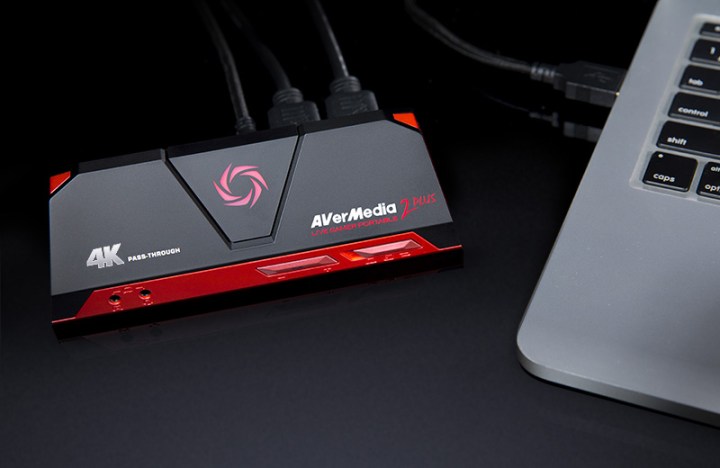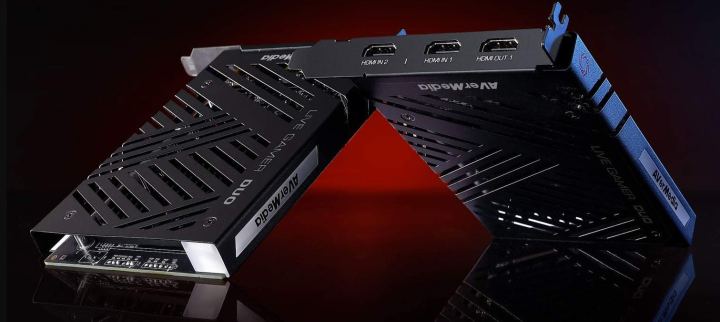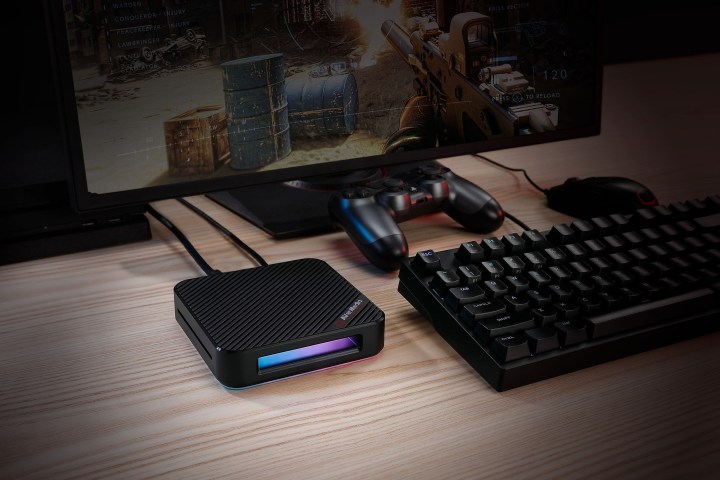
You need the best capture card if you want to record or stream your gameplay with the best quality possible. Our top pick for 2023 is Elgato's HD60 X due to its excellent value, high peak resolution and frame rate, and relatively slim package. But there are a half-dozen other great options on the market as well.
Regardless of whether you're aspiring to stream on Twitch or just grab clips of gameplay to upload to YouTube, we've rounded up the best capture devices from Elgato, EVGA, AverMedia, and more. We have both external and PCIe capture cards below as well, so there's something for everyone.










The best capture card
Elgato HD60 X
- 4K60 passthrough with HDR
- 2K capture with 10-bit HDR
- Variable refresh rate support
- A little expensive
- No hardware encoder
Elgato's HD60 S has been our go-to capture card for a few years, but it has a new challenger: The HD60 X. It comes with the same high-level features as our old favorite, but with a few key extras that push it to be the best capture card you can buy.
For basics, it supports gameplay capture at up to 4K at 30 frames per second (fps), or up to 1440p at 60 fps. In its 1080p60 mode, you can also capture 10-bit HDR. Over the HD60 S+, the HD60 X supports 1440p capture, which is perfect for PC and Xbox Series X gameplay.
The big difference comes in the passthrough, though. You can passthrough HDR and your full resolution and frame rate, up to 4K60. The HD60 X also supports variable refresh rate (VRR). Both the Xbox Series X and PlayStation 5 support VRR now, and the HD60 X allows you to take advantage of it for tear-free gaming while you play.
The HD60 X balances the modern features gamers need without bloating the price with obscene resolutions and frame rates. Even better, it's small and lightweight, so you don't need to worry about a bulky capture card alongside your console.


The best capture card for Xbox Series X
Asus Tuf Gaming CU4K30
- Aluminum body
- 4K60 passthrough
- RGB lighting
- No 4K60 capture
If you're looking for an external capture card for the Xbox Series X, the Asus Tuf Gaming CU4K30 is a great option. As the name implies, you can record or stream gameplay at up to 4K resolution at 30 fps. The card also supports 60 fps capture at 2K, as well as 120 fps capture at 1080p. Make sure to read our guide on how to stream on an Xbox Series X to get your card set up.
The passthrough lets you enjoy your gameplay at its full resolution and frame rate, too. You can passthrough up to a 4K signal at 60 fps, or up to 240 fps in the 1080p mode. Asus supports HDR through the passthrough, too.
To keep all of your cables tidy, the card includes a headphone and controller port on the front, so you can easily plug everything in without cords reaching to your console or PC. The capture card connects to your streaming computer with a single USB-C cable, too, which works out of the box. You don't need to download drivers to start using the card.
Although the looks of a capture device usually don't matter, the CU4K30 looks great. It's a tiny, aluminum capture card with an understated Asus Tuf logo on top. It has some RGB underglow, too, which conveniently tells you about different statuses of the cards, such as if the HDMI signal has been interrupted or if the firmware is updating.


The best capture card for Nintendo Switch
AverMedia Live Gamer Portable 2 Plus
- Small and portable
- 4K passthrough
- MicroSD recording
- Mac users need third-party software
The Nintendo Switch’s portability makes it a great choice for traveling gamers, and with the right carrying case, you can even take the system’s dock with you. If you want to record gameplay on the go but don’t want to bring a PC, the AverMedia Live Gamer Portable 2 Plus is the best capture card for Nintendo Switch. Although it's a great gaming capture card for Nintendo's hybrid console, it also works with PS5, PS4, Xbox Series X, and Xbox One.
With the Live Gamer Portable 2 Plus, you can record gameplay without a tethered PC using its built-in H.264 encoder. It captures in 1080p at 60 fps, which is the ceiling for the Nintendo Switch’s limited capabilities. It saves your video to a microSD card, which you can access through the device's Micro USB connection to a PC (storage mode) or by transferring the microSD card to a PC. Read our guide on how to livestream on Nintendo Switch to get that set up.
The one major downside of the AverMedia Live Gamer Portable 2 Plus is that its proprietary software only works with Windows. The company offers an "express" version in beta for Macs, but you'll likely need third-party software like OBS and XSplit (bookmark our guide on how to use OBS).


The best capture card for $100
AverMedia Live Gamer Mini
- Built-in hardware H.264 encoder
- 1080p streaming at 60 fps
- Live passthrough
- Lacking Mac software
The AverMedia Live Gamer Mini is all you really need for streaming, and at $100, it's cheap, too. It supports 1080p recording and streaming at 60 fps, and the card comes with zero-lag passthrough, allowing you to monitor your gameplay in real-time. In some ways, the Live Gamer Mini even beats out capture cards that are twice its price.
That's mainly thanks to its H.264 hardware encoder. Like the increasingly rare Elgato HD 60, the Live Gamer Mini takes the encoding workload off your CPU when streaming or recording. Because the card handles encoding, you can even capture backup recordings of your stream with StreamEngine. StreamEngine is a lightweight application included with the Live Gamer Mini, allowing you to capture your gameplay before it heads to your broadcasting software of choice.
Like the Live Gamer Portable 2 Plus above, this capture card comes with AverMedia's RECentral software. With scene transitions, chroma key support, and an audio mixer, RECentral has everything you need to stream to YouTube, Twitch, Facebook, and more. If you prefer a different broadcasting software, the Live Gamer Mini supports XSplit, OBS, and OBS Studio, too.
The AverMedia Live Gamer Mini also comes with chroma key support and the audio mixer, though it lacks live editing and the performance optimizations featured in the full Windows version.


The best capture card for PC
Elgato 4K60 Pro Mk.2
- HDR support
- 4K recording at 60 fps
- Multi-app support
- Expensive
- High system requirements
The Elgato 4K60 Pro Mk.2 is an internal capture card to end all capture cards, and it comes with a price tag to match. As the only internal card on our list, the 4K60 Pro benefits from much larger bandwidth thanks to its PCIe x4 interface, outracing USB 3.0 in every circumstance and making USB 2.0 look like a relic.
Of course, the standout feature for the 4K60 Pro Mk.2 is that it can record at 2160p at 60 fps. It also supports 1080p60, as well as HDR10 so you can record gameplay in the best HDR games.
This is a PC gamer's capture card, though. Although slotting a PCIe card into your computer is no tough task, simply opening the side panel may be too much. If you fit in that camp but still want the best in quality, our next pick is perfect for you.
Thankfully, the Elgato 4K60 Pro is worth the hassle. It includes the same excellent features seen on the HD60 S, including Flashback Recording, as well as passthrough at up to 1080p240 or 1440p144.


The best capture card for PlayStation 5
Elgato Game Capture 4K60 S+
- H.264/H.265 encoding
- Built-in SD card reader
- 4K recording at 60 fps
- Very expensive
- No high-resolution passthrough
The Elgato Game Capture 4K60 S+ is, basically, a 4K60 Pro in a box. Nearly twice the price of the PCIe variant, the 4K60 S+ clocks in at a staggering $400. It does, however, have some perks over the base 4K60 Pro.
Namely, the S+ comes with an H.264/H.265 hardware encoder built in. With the onboard encoder, you don't even need a PC to use the 4K60 S+. With the built-in SD card reader, you can easily capture gameplay free of a PC, all at 4K60. Plus, the 4K60 S+ supports HDR in case you want to show off your PlayStation 5 (make sure to read our guide on how to stream on a PS5).
There are some cons to going external, though. The 4K60 S+ doesn't support high-resolution/frame-rate passthrough like the PCIe version, and "Instant Gameview," a feature we'll touch on in a moment, is delayed by 250 milliseconds. Still, the 4K60 S+ is an absolute house when it comes to capturing your gameplay at the highest resolutions and frame rates.


The best PCIe capture card
AverMedia Live Gamer Duo
- Two HDMI inputs
- HDR support
- 4K60 passthrough
- No 4K recording
- Expensive
All of the capture cards above only come with a single input and a single output, so you can only ever stream or record a single source at once. The AverMedia Live Gamer Duo, on the other hand, allows you to record two sources at the same time. Even better, you can record or stream a full 1080p signal at 60 fps from both sources.
So, if you aren't content with your webcam, you can hook up a DSLR to the second input to add some polish to your stream. You'll want to hook up your camera to the second input, though. The first input on the card supports HDR, so you can capture HDR gameplay on the PS4 Pro and Xbox One X.
The card is pricey at around $250, and it's a PCIe card, so you'll need a free spot on your computer. Compared to cards in the same price bracket -- namely the Elgato 4K60 Pro -- the Live Gamer Duo doesn't support 4K recording or streaming. It does, however, support 4K passthrough at 60 fps, so you can still enjoy the full graphical fidelity of whatever game you're playing. If you favor frame rate over resolution, you can also passthrough a 1080p stream at up to 240Hz or a 1440p at up to 144Hz.
For software, the AverMedia Live Gamer Duo includes AverMedia's RECentral software, though it also supports just about every other broadcasting software available. The card comes with RGB lighting on the side, too, allowing you to light up your card with whatever color you want.


The best cheap capture card
EVGA XR1 Lite
- 1080p60 recording and streaming
- Full 4K60 passthrough
- Inexpensive
- Some issues with HDCP
- No HDR support
EVGA's original XR1 was a good, but not great, capture card. It was a little too expensive, but the XR1 Lite fixes that. It's only $100, and it supports a full 1080p resolution at 60 fps, either streaming or recording. Even better, it includes a 4K60 passthrough so you can play your Xbox Series X or PlayStation 5 games at the full resolution and frame rate.
In addition, it's certified by OBS, so all you need to do is plug in the capture card in start going. It can have some problems with HDCP (piracy protection on HDMI cables), but recent consoles can disable this protection in the settings.
Even with that quibble, the XR1 Lite is everything you need to get started recording your gameplay or steaming on Twitch. It's only $100, but frequently goes on sale for around $60. At that price, it's an absolute steal.


The best Thunderbolt capture card
AverMedia Live Gamer Bolt
- 4K recording at 60 fps
- Thunderbolt 3 connection
- Low-latency monitoring
- Expensive
- Requires Thunderbolt connection to work
Thunderbolt is a surprisingly underut-lized connection in the world of capture cards, but AverMedia's Live Gamer Bolt aims to change that. It's an external Thunderbolt 3 capture card, and that connection makes a world of difference in the quality level the card can support.
Over the wire, it can record up to 4K at 60 fps with HDR, as well as 1440p at up to 144 fps and 1080p at up to 240 fps. Those resolutions and frame rates are usually only possible with a PCIe capture card.
You'll need a decent PC to record at that quality, though. AverMedia recommends an Intel Core i7-7700HQ, along with an Nvidia GTX 1050 Ti at minimum.
Thankfully, you don't need a passthrough monitor. The card supports up to 4K at 60 fps passthrough, but you can use the included software for real-time monitors. AverMedia quotes less than 50ms of latency, so you shouldn't have any issues while playing.

Frequently Asked Questions
Using a capture card is pretty simple. It sits between whatever system you're playing on and your screen, stealing a copy of what's going to your screen. In most cases, that means an HDMI cable going from your console or PC to the capture card, and then another HDMI cable going from the capture card to your TV or monitor.
Then, there's usually a USB cable that connects that capture card to your PC. Once everything is hooked up and powered on, you can add the capture card as an input device in streaming/capturing software, such as OBS Studio.
Choosing a capture card is actually fairly easy, as long as you know what to look for. The most important spec is the maximum resolution and frame rate the capture card supports. If you're using a PS5 or Xbox Series X, especially, it's important to pick up a capture card that can deliver the full resolution and frame rate of your console. If you're just streaming gameplay, not capturing it, you can get by with a lower resolution (streaming at 4K consistently is still a few years off).
Then, there's the connection method. Five of the seven options above connect via a USB cable, but some use a PCIe connection. PCIe capture cards slot into an open space in your PC, and although they look different, they perform the same function. The only difference is that PCIe has more bandwidth than USB, making PCIe capture cards ideal for capturing lossless or near-lossless gameplay.
Finally, consider the passthrough. Your capture card may limit the resolution and frame rate of your games, depending on what the passthrough supports. The Elgato Game Capture HD60 S+, for example, supports 4K passthrough at 60 fps, allowing you to enjoy the full resolution of a PS5 or Xbox Series X while streaming or recording.
Although the PS5 and Xbox Series X can capture gameplay internally, it's best to use a capture card. Not only will a capture card allow you to set up your stream how you want with programs like XSplit and OBS, but it will also allow you to capture higher-quality gameplay.
Without getting too technical, video encoding is extremely demanding on a system's processor, and capturing gameplay internally usually leads to lower quality encoding. That's why, if you can record at higher resolutions, you can usually only record for a certain period of time.
A capture card solves that problem, allowing you to customize the quality of your gameplay, as well as record for longer and at higher resolutions. A good capture card is essential for streaming, too, providing you with the full quality of the game you're playing while handling the streaming separately.



